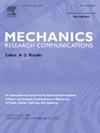FPGA-accelerated Binary Neural Networks as a surrogate model for a viscoplastic constitutive law in impulsively loaded beams
IF 2.3
4区 工程技术
Q3 MECHANICS
引用次数: 0
Abstract
In the present study, constitutive equations are replaced by a new type of energy-efficient neural networks that lead to significantly shorter computation times. We propose this method for impulsively loaded structures exhibiting strain-rate-dependent plasticity and replacing the material law with a so-called Binarized Neural Network (BNNs) in an in-house Finite Element algorithm. BNNs share the same architecture as the Feedforward Neural Networks (FFNNs) but utilize binary layers in place of dense layers. The motivation for employing BNNs lies in the possibility that the binary operations within the binary layers can be optimized for hardware implementation. Specifically, BNNs allow for effective programming of Field Programmable Gate Arrays (FPGAs), enabling the efficient execution of BNNs forward passes in terms of computation time and energy consumption, thus improving the performance of real-time dynamic simulations. Thus in the present study, a BNN is deployed to learn the non-linear viscoplastic material law and the PYNQ Z2 FPGA board has been programmed to process the forward pass of the BNN efficiently. The computation time of the BNN forward pass in the PYNQ Z2 FPGA is 60% faster than in 13th Gen. Intel i7-13700K CPU and 26% faster than in NVIDIA GeForce RTX 4090 GPU.
fpga加速二元神经网络作为脉冲加载梁粘塑性本构律的替代模型
在本研究中,本构方程被一种新型的节能神经网络所取代,从而大大缩短了计算时间。我们提出这种方法用于具有应变率相关塑性的脉冲加载结构,并在内部有限元算法中用所谓的二值化神经网络(bnn)取代材料律。bnn与前馈神经网络(ffnn)共享相同的架构,但使用二进制层代替密集层。使用bnn的动机在于二进制层内的二进制操作可以针对硬件实现进行优化。具体而言,bnn允许对现场可编程门阵列(fpga)进行有效编程,从而在计算时间和能耗方面实现bnn正向传递的有效执行,从而提高实时动态仿真的性能。因此,在本研究中,部署了一个BNN来学习非线性粘塑性材料规律,并编程了PYNQ Z2 FPGA板来有效地处理BNN的正向传递。在PYNQ Z2 FPGA中,BNN正向传递的计算速度比第13代Intel i7-13700K CPU快60%,比NVIDIA GeForce RTX 4090 GPU快26%。
本文章由计算机程序翻译,如有差异,请以英文原文为准。
求助全文
约1分钟内获得全文
求助全文
来源期刊
CiteScore
4.10
自引率
4.20%
发文量
114
审稿时长
9 months
期刊介绍:
Mechanics Research Communications publishes, as rapidly as possible, peer-reviewed manuscripts of high standards but restricted length. It aims to provide:
• a fast means of communication
• an exchange of ideas among workers in mechanics
• an effective method of bringing new results quickly to the public
• an informal vehicle for the discussion
• of ideas that may still be in the formative stages
The field of Mechanics will be understood to encompass the behavior of continua, fluids, solids, particles and their mixtures. Submissions must contain a strong, novel contribution to the field of mechanics, and ideally should be focused on current issues in the field involving theoretical, experimental and/or applied research, preferably within the broad expertise encompassed by the Board of Associate Editors. Deviations from these areas should be discussed in advance with the Editor-in-Chief.

 求助内容:
求助内容: 应助结果提醒方式:
应助结果提醒方式:


